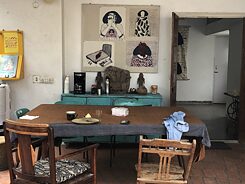 © Nandin Reschke
© Nandin Reschke
I'm sitting at the big table on the terrace of 1 Shanthi Road, the art space in Shantinagar, which will be my home for the next 5 weeks. I think this will be my favourite place - a place in between - open for encounters. I have already understood how the coffee machine works here, while many other questions
pile up inside me.
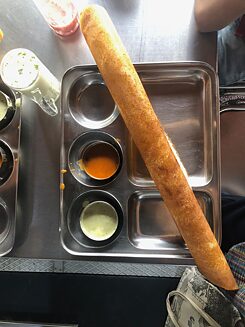 © Nandin Reschke
© Nandin Reschke
Bangalore is loud and intense. The sounds of the street in my head, I feel permeable and thin skinned. I am restless and would like to start concentrating on my project. But first I need coffee and a dosa, a thin, crepe-like pancake with hot sauces.
In the first week, I am impressed and exhausted by Bangalore's complexity. I try to arrive, rearrange and set up my studio and get to know the other artists in 1 Shanthi Road. I explore the immediate surroundings in Shantinagar and observe the use of fabrics and textiles in the urban area. No matter where you are, textiles appear in every way. Laundry is hung outside the houses to dry, so metre-long saris with bright colours and patterns cover the facades. Fabrics are used to temporarily extend built architectures to the outside, for example through canopies and roof structures such as the shade dispensers at the KR flower market. During these first city tours, I also understand that the traffic sometimes completely paralyses this city and that it will take me hours to get through it with Uber taxis, autorickshaws or the Metro. Walking is not possible.
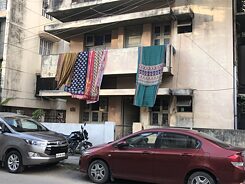 © Nandin Reschke
© Nandin Reschke
Suresh, the founder of 1 Shanthi Road, gives us newly-arrived artists a presentation about the history of Bangalore. He talks about Kempe Gowda's original urban planning in the 16th century, its mixture of parks, gardens, a market, a fortress and the various producing communities that had to interact to shape the city.
I notice that the longer I am here, the less tangible the city becomes for me. It confuses me. I originally planned to develop my work in Bangalore directly with weavers and people in the textile sector who are involved in direct production. I wanted to work on hand looms and cooperate with weavers who, as an increasing minority, continue this long tradition to this day. A tradition that Mahatma Gandhi already understood as a form of peaceful protest, in which the poorer population should gain independence through the creation of their own khadi and the knowledge of weaving. It quickly turns out that such a cooperation cannot be realised in the short time I am here.
After that, a vacuum develops, an emptiness in me that is difficult to endure at first. An artist-in-residence in a different culture is always a challenge, not only physically, due to different eating habits and the changed climate, but also emotionally. It brings you out of the comfort zone and raises many questions. But this state of uncertainty is a perfect starting point for a new work.
The starting point of my project is my everyday experiences as a woman in Bangalore. I have to admit that the city completely intimidates and unsettles me: how do I move, how do I look, what kind of gestures do I use? How are these experiences influenced by my gender?
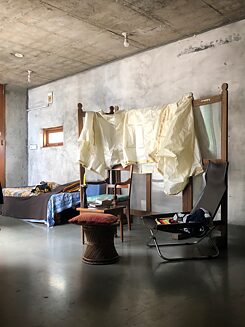 © Nandin Reschke
© Nandin Reschke
I feel restricted on many levels, also in my physical movement. I start attending dance classes to compensate for that. When I walk home from the dance class in the dark at 9.00 p.m., I feel uncomfortable. Male friends tell me not to worry. I am not worried, but my embodied experience cannot be denied. I join a friend who jogs through the Lal Bagh Botanical Gardens every morning. Through conversations with her, I understand that everyone develops their own tactics to deal with gender restrictions in everyday life in this city.
From here it's just one more step and I'm in the middle of my work: I start having conversations with other women about their lives in Bangalore. Do we experience anything similar? I ask how the immediate environment affects us. I ask how we navigate gender-specific spaces, where we can feel safe, and how gender roles shape our lives within family environments.
My artistic way of working is always based on the direct exchange with people. My practice focuses on creating processes that enable communication. During the talks, we explore similarities and differences in our experiences. In the encounters, I experience that we have a lot in common. Asking and listening allows me to understand myself better in this situation. I am impressed by many of the different strategies of appropriating the city.
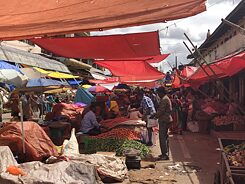 © Nandin Reschke
© Nandin Reschke
Bangalore is a city of strangers: a metropolis of people, cultures and languages from many different regions. For some it is a place of liberation, for others it means restriction, exclusion and even loss of rights and freedom. The many conversations not only change my perception of the city but also my feeling and behaviour in the city. I'm getting more confident again. With this confidence comes the final idea of realising the work.
In my work, I use fabrics and textiles as sculptural material, as a carrier of identities, of collective history and individual experiences. During my time in Bangalore I research various local textile traditions, visit weaving mills, speak to the producers and sellers of fabrics and textiles. I start collecting saris because I am fascinated by this 6 metre long completely uncut fabric, which can be wrapped around the body in a hundred different ways to become a garment. I research the designs of the saris more closely to understand their colours and patterns, especially on the border. I am particularly interested in the
Pallu, the end of the saree, which no longer fulfils a function, but is thrown over the shoulder and folded for decoration. The
Pallu almost always consists of lines and geometric shapes that form a frame.
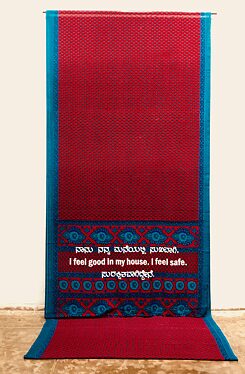 © Nandin Reschke
© Nandin Reschke
These shapes and lines finally prompt me to print individual statements from the conversations as text on the sarees, as if each saree was telling a story. Text and textile: Both words have the same origin - which comes from Latin and means "to weave". A text is woven from words, sometimes you find a thread that guides you while reading. I want the texts to become so much part of the saree that both text and textile find each other to be equivalent.
Together with a designer from Bangalore, who is part of the project, we create a graphic layout for each individual saree. A local screen printer prints them, a total of 15 saris, each of them being a unique piece - the complete contrary to the possibilities of the reproducible process.
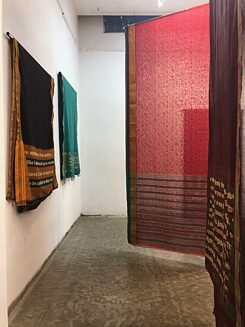 © Nadin Reschke
© Nadin Reschke
I hang the printed sarees in a large-scale textile installation in the gallery of 1 Shanthi Road Gallery, a temporary presentation that recognizes gender-specific realities, but also touches on issues and concerns of different sexualities, gender identities and sexual violence against women and gender minorities.
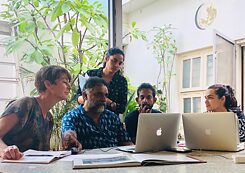 © Nandin Reschke
© Nandin Reschke
The work has been realised with the contributions of many people. I would like to give special thanks to all the women who made this project happen, especially Avnit, Shrunga, Devi, Arshi, Mona, Shilok, Anisha, Harshita, Sandhya, Anitha, Siri and Anna and all the others. Thanks to Shrunga for helping with the graphic layout, to Ashok for editing the texts, to Sandhya for translating, Sandeep for his advice, the tailor lady, whose name I forget, for stitching and the ironing man for the fabrics. A special thanks to everyone at 1 Shanthi Road for creating such a great place to feelat home, Flo, Yana and Magdalena and also Simon and Sancintya for listening to me and giving me critical advice, and of course to the Goethe-Institut - the whole team - for their support and constant help in everything that was needed in this project.







